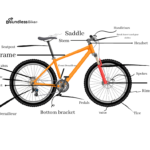Are you looking to improve your cycling performance, especially when tackling steep hills and challenging terrain? One way to do this is by upgrading your bike’s cassette. But what exactly is a cassette, and can you put a bigger one on your bike?
In this blog post, we’ll explore the benefits of a larger cassette size, how to change it, potential drawbacks to consider, and whether or not it’s right for you. So buckle up (or rather, clip in) as we dive into the world of bike cassettes!
Can I Put a Bigger Cassette on My Bike?

If you’re wondering if you can put a bigger cassette on your bike, the answer is most likely yes. But before making any changes, it’s important to understand what a cassette is and how it affects your cycling performance.
A cassette refers to the set of gears located on the rear wheel hub of your bike. It consists of multiple cogs with varying numbers of teeth that determine gear ratios and affect resistance levels when pedaling.
Determining what size cassette you need will depend on your personal fitness level, riding style, and terrain type. If you find yourself struggling with steep hills or feel like your current gear setup doesn’t offer enough range for different riding conditions, then upgrading to a larger cassette may be beneficial.
Changing out a cassette can seem daunting at first but with some basic tools and knowledge, it’s relatively straightforward. However, keep in mind that altering the size of your cassette could potentially require other modifications such as chain length adjustments or derailleur tweaks.
Ultimately, deciding whether or not to go for a bigger cassette depends on individual preferences and goals. Consider consulting with a professional mechanic or experienced rider before making any changes to ensure they align with your specific needs.
What Is a Cassette?

A cassette, in terms of cycling, refers to the collection of gears located on the rear wheel hub. It is made up of several individual sprockets that vary in size and are stacked on top of each other. A typical road bike cassette can have anywhere from 9 to 12 sprockets.
The cassette works together with the chain and front chainrings to determine your bike’s gear ratio. This determines how easily you can pedal uphill or how fast you can go downhill.
Each cog on a bicycle cassette has a different number of teeth – fewer teeth make it harder to turn (often used for climbing steep hills), while more teeth make it easier (for faster speeds). With this range of options, riders are able to adjust their gearing according to their terrain and preferred riding style.
Cassettes come in various sizes and configurations, which means there’s always one that suits your biking needs – whether you’re riding through hilly terrains or just cruising over flat roads.
What Size Cassette Do I Need?
Choosing the right cassette size for your bike plays a crucial role in determining how efficiently you can pedal. The number of teeth on the rear cassette determines the gear ratio, which affects your ability to climb hills or go fast on flat terrain.
If you’re an experienced rider, you might have an idea of what cassette size works best for you based on your riding style and fitness level. However, if you’re new to cycling or upgrading your drivetrain, it’s essential to consider a few factors before choosing a cassette.
The first thing is to determine your fitness level and preferred cadence. If you prefer spinning at higher speeds with less resistance, then a smaller cassette with lower gears is ideal. On the other hand, if you want more power and speed when pedaling hard uphill climbs, then a larger cassette with higher gears would be better suited.
It’s also important to consider the type of riding that you’ll be doing most frequently. For example, mountain bikers may benefit from wider range cassettes as they allow them more flexibility in tackling steep gradients and technical terrain.
Ultimately, choosing the right size cassette boils down to personal preference and riding style – there isn’t one perfect answer that will work for everyone!
| Cassette Type | Number of Speeds | Gear Range | Smallest Cog Size (Teeth) | Largest Cog Size (Teeth) |
|---|---|---|---|---|
| Shimano CS-HG50 | 9-speed | 11-25T, 11-28T, 11-30T, 11-32T | 11T | 25T, 28T, 30T, 32T |
| Shimano CS-HG400 | 9-speed | 11-25T, 11-28T, 11-32T | 11T | 25T, 28T, 32T |
| Shimano CS-HG200 | 9-speed | 11-32T | 11T | 32T |
| Shimano CS-HG800 | 11-speed | 11-34T, 11-36T, 11-40T, 11-42T, 11-46T | 11T | 34T, 36T, 40T, 42T, 46T |
| Shimano CS-R7000 | 11-speed | 11-25T, 11-28T, 11-30T, 11-32T | 11T | 25T, 28T, 30T, 32T |
| SRAM PG-950 | 9-speed | 11-26T, 11-28T, 11-32T | 11T | 26T, 28T, 32T |
| SRAM PG-970 | 9-speed | 11-21T, 11-23T, 11-26T, 11-28T | 11T | 21T, 23T, 26T, 28T |
| SRAM XG-1150 | 11-speed | 10-42T | 10T | 42T |
| SunRace CSM980 | 9-speed | 11-40T, 11-42T | 11T | 40T, 42T |
| SunRace CSMX8 | 11-speed | 11-42T, 11-46T | 11T | 42T, 46T |
How Do I Change My Cassette?
Changing your cassette can be intimidating for some riders, but it’s actually a relatively simple process that can be done with just a few tools. Here’s how to change your cassette in a few easy steps.
First, you’ll need to remove the rear wheel from your bike. Then, use a chain whip to hold the cassette still while using a cassette lockring tool to unscrew the lockring and remove the old cassette.
Next, clean both the freehub body and new cassette before installing the new one onto the freehub body. Make sure that you align any notches or grooves on both components before tightening down with your hands.
Use your chain whip and lockring tool again to tighten down the new cassette securely onto your bike’s rear wheel hub. Reinstalling and securing back in place everything else after doing this step will let you ride smoothly with your newly changed gear!
Remember that if you’re unsure about changing out cassettes yourself or don’t have access to proper tools at home, it’s always best to seek help from an experienced mechanic at a local bike shop!
What are the Benefits of a Bigger Cassette?
Having a bigger cassette on your bike can provide several benefits to riders. First and foremost, it offers a wider range of gears, allowing riders to tackle steeper climbs or go faster on flat roads without having to exert as much effort.
A larger cassette also provides smoother gear shifting, which can enhance your overall riding experience. With more teeth on the cassette, each shift is less drastic than with a smaller cassette, resulting in a more seamless transition between gears.
Riders who enjoy off-road biking may find that a bigger cassette helps them better navigate difficult terrain by providing lower gears for uphill sections and higher gears for downhill stretches.
Additionally, upgrading to a larger cassette can be more cost-effective than replacing an entire drivetrain system. Riders who want to improve their bike’s performance but are working within budget constraints may find this option particularly appealing.
While there are some potential drawbacks to consider when changing your bike’s cassette size, the benefits of doing so can greatly enhance both your ride quality and overall enjoyment of cycling.
How to Put a Bigger Cassette on Your Bike
If you’ve decided that a bigger cassette is right for your riding style, the next step is to figure out how to install it on your bike. Here’s what you need to do:
1. Gather your tools: You’ll need a chain whip, a cassette lockring tool, and possibly some pliers or an adjustable wrench.
2. Remove the old cassette: Use the chain whip to hold the cassette in place while you use the lockring tool to unscrew the lockring. Once it’s loose, remove it and slide off the old cassette.
3. Install the new cassette: Slide on your new cassette in reverse order of removal – first putting on any spacers that came with it, then sliding each cog onto its corresponding spline.
4. Tighten everything up: Screw on the lockring using your lockring tool and tighten as much as possible.
5. Adjust derailleur if necessary: Since a bigger cassette means more gears, there may be some adjustments needed to keep shifting smooth and accurate.
Are There any Drawbacks to a Bigger Cassette?
While a larger cassette can offer benefits such as easier climbing and improved cadence, there are also a few drawbacks to consider.
Opting for a bigger cassette will likely require the need for a longer chain. This means additional cost in purchasing an extended chain or even replacing your current one altogether. Additionally, you may also have to adjust the derailleur and potentially even upgrade it to accommodate the larger size.
Another potential downside is that a bigger cassette could affect your shifting performance. With more gears available, there are more complexities at play which could make shifting less smooth or cause skipped shifts if not set up properly.
It’s worth noting that adding more teeth to your cassette can increase weight on your bike. While this might not be noticeable for some riders, those who prioritize lightweight equipment should take note of any added grams.
Ultimately, deciding whether or not to switch to a bigger cassette depends on individual preferences and riding styles. It’s important to weigh both the pros and cons before making any changes and seek professional advice if necessary.
How Do I Know If a Bigger Cassette is Right For Me?
Choosing the right cassette size for your bike depends on a few things. First, consider what kind of riding you do most often. If you spend a lot of time climbing steep hills or mountains, then going with a bigger cassette could be beneficial. A larger cassette will give you more gears to choose from and make it easier to spin up those hills without burning out your legs.
However, if you’re primarily riding flats or rolling terrain, a bigger cassette may not be necessary. In fact, it could even slow you down by adding extra weight and decreasing your top-end speed.
Another factor to consider is your fitness level. If you’re an experienced rider with strong leg muscles and good aerobic capacity, then upgrading to a bigger cassette might make sense as it can provide greater versatility in challenging situations that require varied speeds and torque requirements.
Think about the type of bike you have and its drivetrain components when deciding whether or not to upgrade your cassette size. Certain bikes are designed specifically for use with certain types of cassettes so ensure that any change in gear groupset specifications is compatible before making changes.
Conclusion
Upgrading to a bigger cassette can be a great way to improve your cycling experience. The benefits of having more gears and being able to tackle steeper hills with ease are undeniable. However, it’s important to consider the potential drawbacks such as added weight and cost before making the switch.
If you’re unsure whether or not a bigger cassette is right for you, consult with a professional bike mechanic who can help guide you in the right direction. Ultimately, it comes down to personal preference and what type of riding you plan on doing.
No matter what size cassette you choose, make sure to take good care of your bike by regularly cleaning and maintaining it. With proper upkeep, your bike will continue to perform at its best for years to come. Happy cycling!
Also Read: Why Are Road Bike Handlebars Curved? Complete Answer






